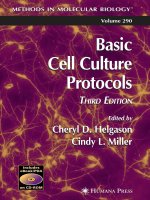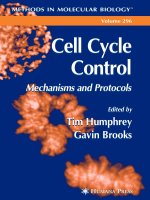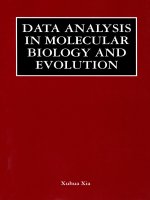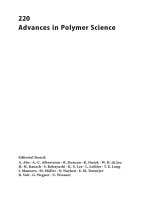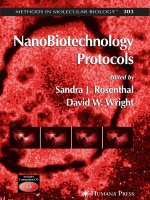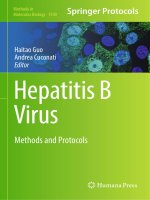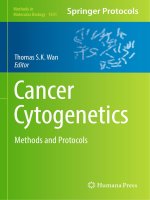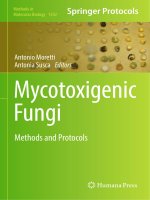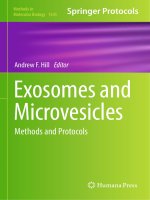- Trang chủ >>
- Khoa Học Tự Nhiên >>
- Vật lý
methods in molecular biology, v.474. nanostructure design. methods and protocols, 2008, p.268
Bạn đang xem bản rút gọn của tài liệu. Xem và tải ngay bản đầy đủ của tài liệu tại đây (6.84 MB, 268 trang )
Nanostructure Design
METHODS IN MOLECULAR BIOLOGY™
John M. Walker, SERIES EDITOR
474. Nanostructure Design: Methods and Protocols, edited
by Ehud Gazit and Ruth Nussinov, 2008
473. Clinical Epidemiology: Practice and Methods, edited
by Patrick Parfrey and Brendon Barrett, 2008
472. Cancer Epidemiology, Volume 2: Modifiable Factors,
edited by Mukesh Verma, 2008
471. Cancer Epidemiology, Volume 1: Host Susceptibility
Factors, edited by Mukesh Verma, 2008
470. Host-Pathogen Interactions: Methods and Protocols,
edited by Steffen Rupp and Kai Sohn, 2008
469. Wnt Signaling, Volume 2: Pathway Models, edited by
Elizabeth Vincan, 2008
468. Wnt Signaling, Volume 1: Pathway Methods and
Mammalian Models, edited by Elizabeth Vincan, 2008
467. Angiogenesis Protocols: Second Edition, edited by
Stewart Martin and Cliff Murray, 2008
466. Kidney Research: Experimental Protocols, edited by
Tim D. Hewitson and Gavin J. Becker, 2008.
465. Mycobacteria, Second Edition, edited by Tanya Parish
and Amanda Claire Brown, 2008
464. The Nucleus, Volume 2: Physical Properties and
Imaging Methods, edited by Ronald Hancock, 2008
463. The Nucleus, Volume 1: Nuclei and Subnuclear
Components, edited by Ronald Hancock, 2008
462. Lipid Signaling Protocols,
edited by Banafshe
Larijani, Rudiger Woscholski, and Colin A. Rosser, 2008
461. Molecular Embryology: Methods and Protocols,
Second Edition, edited by Paul Sharpe and Ivor Mason,
2008
460. Essential Concepts in Toxicogenomics, edited by
Donna L. Mendrick and William B. Mattes, 2008
459. Prion Protein Protocols, edited by Andrew F. Hill, 2008
458. Artificial Neural Networks: Methods and
Applications, edited by David S. Livingstone, 2008
457. Membrane Trafficking, edited by Ales Vancura, 2008
456. Adipose Tissue Protocols, Second Edition, edited by
Kaiping Yang, 2008
455. Osteoporosis, edited by Jennifer J. Westendorf, 2008
454. SARS- and Other Coronaviruses: Laboratory
Protocols, edited by Dave Cavanagh, 2008
453. Bioinformatics, Volume 2: Structure, Function, and
Applications, edited by Jonathan M. Keith, 2008
452. Bioinformatics, Volume 1: Data, Sequence Analysis,
and Evolution, edited by Jonathan M. Keith, 2008
451. Plant Virology Protocols: From Viral Sequence to
Protein Function, edited by Gary Foster, Elisabeth
Johansen, Yiguo Hong, and Peter Nagy, 2008
450. Germline Stem Cells, edited by Steven X. Hou and
Shree Ram Singh, 2008
449. Mesenchymal Stem Cells: Methods and Protocols,
edited by Darwin J. Prockop, Douglas G. Phinney,
and Bruce A. Brunnell, 2008
448. Pharmacogenomics in Drug Discovery and
Development, edited by Qing Yan, 2008.
447. Alcohol: Methods and Protocols, edited by Laura E.
Nagy, 2008
446. Post-translational Modifications of Proteins: Tools
for Functional Proteomics, Second Edition, edited by
Christoph Kannicht, 2008.
445. Autophagosome and Phagosome, edited by Vojo
Deretic, 2008
444. Prenatal Diagnosis, edited by Sinhue Hahn and Laird
G. Jackson, 2008.
443. Molecular Modeling of Proteins, edited by Andreas
Kukol, 2008.
442. RNAi: Design and Application, edited by Sailen Barik, 2008.
441. Tissue Proteomics: Pathways, Biomarkers, and Drug
Discovery, edited by Brian Liu, 2008
440. Exocytosis and Endocytosis, edited by Andrei I.
Ivanov, 2008
439. Genomics Protocols, Second Edition, edited by Mike
Starkey and Ramnanth Elaswarapu, 2008
438. Neural Stem Cells: Methods and Protocols, Second
Edition, edited by Leslie P. Weiner, 2008
437. Drug Delivery Systems, edited by Kewal K. Jain, 2008
436. Avian Influenza Virus, edited by Erica Spackman, 2008
435. Chromosomal Mutagenesis, edited by Greg Davis and
Kevin J. Kayser, 2008
434. Gene Therapy Protocols: Volume 2
: Design and
Characterization of Gene Transfer Vectors, edited by
Joseph M. LeDoux, 2008
433. Gene Therapy Protocols: Volume 1: Production and
In Vivo Applications of Gene Transfer Vectors, edited by
Joseph M. LeDoux, 2008
432. Organelle Proteomics, edited by Delphine Pflieger and
Jean Rossier, 2008
431. Bacterial Pathogenesis: Methods and Protocols, edited
by Frank DeLeo and Michael Otto, 2008
430. Hematopoietic Stem Cell Protocols, edited by Kevin
D. Bunting, 2008
429. Molecular Beacons: Signalling Nucleic Acid Probes,
Methods and Protocols, edited by Andreas Marx and
Oliver Seitz, 2008
428. Clinical Proteomics: Methods and Protocols, edited by
Antonia Vlahou, 2008
427. Plant Embryogenesis, edited by Maria Fernanda
Suarez and Peter Bozhkov, 2008
426. Structural Proteomics: High-Throughput Methods,
edited by Bostjan Kobe, Mitchell Guss, and Thomas
Huber, 2008
425. 2D PAGE: Sample Preparation and Fractionation,
Volume 2, edited by Anton Posch, 2008
424. 2D PAGE: Sample Preparation and Fractionation,
Volume 1, edited by Anton Posch, 2008
423. Electroporation Protocols: Preclinical and Clinical
Gene Medicine, edited by Shulin Li, 2008
422. Phylogenomics, edited by William J. Murphy, 2008
421. Affinity Chromatography: Methods and Protocols,
Second Edition, edited by Michael Zachariou, 2008
420. Drosophila: Methods and Protocols, edited by
Christian Dahmann, 2008
419. Post-Transcriptional Gene Regulation, edited by
Jeffrey Wilusz, 2008
418. Avidin–Biotin Interactions: Methods and
Applications, edited by Robert J. McMahon, 2008
417. Tissue Engineering, Second Edition, edited by
Hannsjörg Hauser and Martin Fussenegger, 2007
416. Gene Essentiality: Protocols and Bioinformatics, edited
by Svetlana Gerdes and Andrei L. Osterman, 2008
415. Innate Immunity, edited by Jonathan Ewbank and Eric
Vivier, 2007
414. Apoptosis in Cancer: Methods and Protocols,
edited by Gil Mor and Ayesha Alvero, 2008
413. Protein Structure Prediction, Second Edition,
edited by Mohammed Zaki and Chris Bystroff, 2008
412. Neutrophil Methods and Protocols, edited by Mark
T. Quinn, Frank R. DeLeo, and Gary M. Bokoch,
2007
Nanostructure Design
Methods and Protocols
Edited by
Ehud Gazit
Faculty of Life Science, Tel Aviv University
Tel Aviv, Israel
Ruth Nussinov
Center for Cancer Research Nanobiology Program
National Cancer Institute, Frederick, MD;
Medical School, Tel Aviv University
Tel Aviv, Israel
METHODS IN MOLECULAR BIOLOGY™
e-ISBN: 978-1-59745-480-3
ISSN: 1064-3745 e-ISSN: 1940-6029
DOI: 10.1007/978-1-59745-480-3
Library of Congress Control Number: 2008921784
© 2008 Humana Press, a part of Springer Science + Business Media, LLC
All rights reserved. This work may not be translated or copied in whole or in part without the written permis-
sion of the publisher (Humana Press, 999 Riverview Drive, Suite 208, Totowa, NJ 07512 USA), except for
brief excerpts in connection with reviews or scholarly analysis. Use in connection with any form of informa-
tion storage and retrieval, electronic adaptation, computer software, or by similar or dissimilar methodology
now known or hereafter developed is forbidden.
The use in this publication of trade names, trademarks, service marks, and similar terms, even if they are
not identified as such, is not to be taken as an expression of opinion as to whether or not they are subject to
proprietary rights.
Cover illustration: Provided by Aleksei Aksimentiev et al. (Chapter 11, Figures 4, 9a, 12, 13A)
Printed on acid-free paper
9 8 7 6 5 4 3 2 1
springer.com
Editors
Ehud Gazit
Department of Molecular Biology
Faculty of Life Science
Tel Aviv University
Tel Aviv, Israel
Ruth Nussinov
Center for Cancer Research Nanobiology
Program
SAIC-Frederick
National Cancer Institute
Frederick, MD
and
Department of Human Genetics
Medical School
Tel Aviv University
Tel Aviv, Israel
Series Editor
John M. Walker
School of Life Sciences
University of Hertfordshire
Hatfield, Hertfordshire AL10 9AB
UK
ISBN: 978-1-934115-35-0
Preface
We are delighted to present Nanostructure Design: Methods and Protocols.
Nanotechnology is one of the fastest growing fields of research of the 21st
century and will most likely have a huge impact on many aspects of our life.
This book is part of the excellent Methods in Molecular Biology
TM
series as
molecular biology offers novel and unique solutions for nanotechnology.
Nanostructure Design: Methods and Protocols is designed to serve as a
major reference for theoretical and experimental considerations in the design
of biological and bio-inspired building blocks, the physical characterization of
the formed structures, and the development of their technological applications.
It gives exposure to various biological and bio-inspired building blocks for the
design and fabrication of nanostructures. These building blocks include pro-
teins and peptides, nucleic acids, and lipids as well as various hybrid bioorganic
molecular systems and conjugated bio-inspired entities. It provides information
about the design of the building blocks both by experimental exploration of
synthetic chemicals and biological prospects and by theoretical studies of the
conformational space; the characterization of the formed nanostructures by var-
ious biophysical techniques, including spectroscopy (electromagnetic as well
as nuclear magnetic resonance) together with electron and probe microscopy;
and the application of bionanostructures in various fields, including biosensors,
diagnostics, molecular imaging, and tissue engineering.
The book is divided into two sections; the first is experimental and the
second computational. At the beginning of the book, Thomas Scheibel and
coworkers describe the use of a natural biological self-assembled system, the
spider silk, as an excellent source for the production of nano-ordered materi-
als. Using recombinant DNA technology and bacterial expression, large-scale
production of the unique silk-like protein is achieved.
In Chapter 2, by Anna Mitraki and coworkers in collaboration with Mark van
Raaij, yet another fascinating biological system is explored for technological uses.
The authors, inspired by biological fibrillar assemblies, studied a small trimeriza-
tion motif from phage T4 fibritin. Hybrid proteins that are based on this motif are
correctly folded nanorods that can withstand extreme conditions.
In Chapter 3, Maxim Ryadnov, Derek Woolfson, and David Papapostolou
study yet another important self-assembly biological motif, the leucine zipper.
Using this motif, the authors demonstrate the ability to form well-ordered fibril-
lar structures. In Chapter 4, Joseph Slocik and Rajesh Naik describe methodolo-
gies that exploit peptides for the synthesis of bimorphic nanostructures. Another
v
demonstration of the use of peptides for self-assembled structures is described
in Chapter 5 by Radhika P. Nagarkar and Joel P. Schneider. The authors use
these peptides for the formation of hydrogel materials that may have many
applications in diverse fields, including tissue engineering and regeneration.
In the last chapter of the book’s experimental section (Chapter 6), Yingfu Li
and coworkers describe a protocol for the preparation of a gold nanoparticle
combined with a DNA scaffold on which nanospecies can be assembled in a
periodical manner. This demonstrates the combination of biomolecules with
inorganic nano particles for technological applications.
In Part II, on the computational approach, Bruce A. Shapiro and coauthors
describe in Chapter 7 recent developments in applications of single-stranded
RNA in the design of nanostructures. RNA nanobiology presents a relatively
new approach for the development of RNA-based nanoparticles.
In Chapter 8, Idit Buch and coworkers describe self-assembly of fused homo-
oligomers to create nanotubes. The authors present a protocol of fusing
homo-oligomer proteins with a given three-dimensional structure to create new
building blocks and provide examples of two nanotubes in atomistic model
details.
The authors of Chapter 9, Joan-Emma Shea and colleagues, present a thor-
ough discussion of the theoretical foundation of an enhanced sampling protocol
to study self-assembly of peptides, with an example of a peptide cut from the
Alzheimer Aβ protein. The self-assembly of Aβ peptides led to amyloid fibril
formation. Thorough and efficient sampling is crucial for computational design
of self-assembled systems.
In Chapter 10, Maarten G. Wolf, Jeroen van Gestel, and Simon W. de Leeuw
also model amyloid fibril formation. The fibrillogenic properties of many pro-
teins can be understood and thus predicted by taking the relevant free energies
into account in an appropriate way. Their chapter gives an overview of existing
simulation techniques that operate at a molecular level of detail.
Klaus Schulten and his coworkers provide an overview in Chapter 11 of the
impressive array of computational methods and tools they have developed that
should allow dramatic improvement of computer modeling in biotechnology.
These include silicon bionanodevices, carbon nanotube-biomolecular systems,
lipoprotein assemblies, and protein engineering of gas-binding proteins, such
as hydrogenases.
In the final chapter (Chapter 12), Ugur Emekli and coauthors discuss the lessons
that can be learned from highly connected β-rich structures for structural interface
design. Identification of features that prevent polymerization of these proteins into
fibrils should be useful as they can be incorporated in interface design.
Biology has already shown the merit of a nanostructure formation process; it
is the essence of molecular recognition and self-assembly events in the orga-
vi Preface
nization of all biological systems. Biology offers a unique level of specificity
and affinity that allows the fine tuning of nanoscale design and engineering.
While much progress has been made, challenges are still ahead. We hope that
Nanostructure Design: Methods and Protocols, which is based on biology and
uses its principles and its vehicles toward design, will be useful for newcomers
and experienced nanobiologists. It can also help scientists from other fields, such
as chemistry and computer science, who would like to explore the prospects of
nanobiotechnology.
Ehud Gazit
Ruth Nussinov
Preface vii
Contents
Preface v
Contributors xi
PART I EXPERIMENTAL APPROACH
1 Molecular Design of Performance Proteins With Repetitive
Sequences: Recombinant Flagelliform Spider Silk as Basis
for Biomaterials 3
Charlotte Vendrely, Christian Ackerschott, Lin Römer,
and Thomas Scheibel
2 Creation of Hybrid Nanorods From Sequences
of Natural Trimeric Fibrous Proteins Using the Fibritin
Trimerization Motif 15
Katerina Papanikolopoulou, Mark J. van Raaij,
and Anna Mitraki
3 The Leucine Zipper as a Building Block for Self-Assembled
Protein Fibers 35
Maxim G. Ryadnov, David Papapostolou,
and Derek N. Woolfson
4 Biomimetic Synthesis of Bimorphic Nanostructures 53
Joseph M. Slocik and Rajesh R. Naik
5 Synthesis and Primary Characterization of Self-Assembled
Peptide-Based Hydrogels 61
Radhika P. Nagarkar and Joel P. Schneider
6 Periodic Assembly of Nanospecies on Repetitive
DNA Sequences Generated on Gold Nanoparticles
by Rolling Circle Amplification 79
Weian Zhao, Michael A. Brook, and Yingfu Li
PART II COMPUTATIONAL APPROACH
7 Protocols for the In Silico Design of RNA Nanostructures 93
Bruce A. Shapiro, Eckart Bindewald, Wojciech Kasprzak,
and Yaroslava Yingling
8 Self-Assembly of Fused Homo-Oligomers to Create Nanotubes 117
Idit Buch, Chung-Jung Tsai, Haim J. Wolfson,
and Ruth Nussinov
9 Computational Methods in Nanostructure Design:
Replica Exchange Simulations of Self-Assembling Peptides 133
Giovanni Bellesia, Sotiria Lampoudi, and Joan-Emma Shea
ix
10 Modeling Amyloid Fibril Formation: A Free-Energy Approach 153
Maarten G. Wolf, Jeroen van Gestel, and Simon W. de Leeuw
11 Computer Modeling in Biotechnology: A Partner
in Development 181
Aleksei Aksimentiev, Robert Brunner, Jordi Cohen,
Jeffrey Comer, Eduardo Cruz-Chu, David Hardy,
Aruna Rajan, Amy Shih, Grigori Sigalov, Ying Yin,
and Klaus Schulten
12 What Can We Learn From Highly Connected β-Rich
Structures for Structural Interface Design? 235
Ugur Emekli, K. Gunasekaran, Ruth Nussinov,
and Turkan Haliloglu
Index 255
x Contents
Contributors
Christian Ackerschott • TUM, Department Chemie, Lehrstuhl
Biotechnologie, Garching, Germany
Aleksei Aksimentiev • Beckman Institute for Advanced Science and
Technology, University of Illinois at Urbana-Champaign, Urbana, IL
Giovanni Bellesia • Department of Chemistry and Biochemistry, University
of California, Santa Barbara, CA
Eckart Bindewald • Basic Research Program, SAIC-Frederick Inc.,
NCI-Frederick, Frederick, MD
Michael A. Brook • Department of Chemistry, McMaster University,
Hamilton, Ontario, Canada
Robert Brunner • Beckman Institute for Advanced Science
and Technology, University of Illinois at Urbana-Champaign, Urbana, IL
Idit Buch • Department of Human Genetics, Sackler Institute of Molecular
Medicine, Sackler Faculty of Medicine, Tel Aviv University, Tel Aviv, Israel
Jordi Cohen • Beckman Institute for Advanced Science and Technology,
University of Illinois at Urbana-Champaign, Urbana, IL
Jeffrey Comer • Beckman Institute for Advanced Science and Technology,
University of Illinois at Urbana-Champaign, Urbana, IL
Eduardo Cruz-Chu • Beckman Institute for Advanced Science and
Technology, University of Illinois at Urbana-Champaign, Urbana, IL
Simon W. de Leeuw • DelftChemTech, Delft University of Technology, Delft,
The Netherlands
Ugur Emekli • Polymer Research Center and Chemical Engineering
Department, Bogaziçi University, Istanbul, Turkey
Ehud Gazit • Department of Molecular Biology, Faculty of Life Science,
Tel Aviv University, Tel Aviv, Israel
K. Gunasekaran • Basic Research Program, SAIC-Frederick Inc., Center for
Cancer Research Nanobiology Program, NCI-Frederick, Frederick, MD
Turkan Haliloglu • Polymer Research Center and Chemical Engineering
Department, Bogaziçi University, Istanbul, Turkey
David Hardy • Beckman Institute for Advanced Science and Technology,
University of Illinois at Urbana-Champaign, Urbana, IL
Wojciech Kasprzak • Basic Research Program, SAIC-Frederick Inc.,
NCI-Frederick, Frederick, MD
Sotiria Lampoudi • Department of Computer Science, University of
California, Santa Barbara, CA
xi
Yingfu Li • Departments of Chemistry and Biochemistry and Biomedical
Sciences, McMaster University, Hamilton, Ontario, Canada
Anna Mitraki • Department of Materials Science and Technology, c/o
Biology Department, University of Crete, Vassilika Vouton, Crete, Greece
Radhika P. Nagarkar • Department of Chemistry and Biochemistry,
University of Delaware, Newark, DE
Rajesh R. Naik • Materials and Manufacturing Directorate, Air Force
Research Lab, Wright-Patterson Air Force Base, OH
Ruth Nussinov • Center for Cancer Research Nanobiology Program,
SAIC-Frederick, National Cancer Institute. Department of Human
Genetics, Medical School, Tel Aviv University, Tel Aviv, Israel
Katerina Papanikolopoulou • Institute of Molecular Biology and
Genetics, Vari 16672, Greece
David Papapostolou • School of Chemistry, University of Bristol, Cantock’s
Close, Bristol, UK
Aruna Rajan • Beckman Institute for Advanced Science and Technology,
University of Illinois at Urbana-Champaign, Urbana, IL
Lin Römer • Universität Bayreuth, Lehrstuhl Biomaterialien, 95440
Bayreuth, Germany
Maxim G. Ryadnov • School of Chemistry, University of Bristol, Cantock’s
Close, Bristol, UK
Thomas Scheibel • Universität Bayreuth, Lehrstuhl Biomaterialien, 95440
Bayreuth, Germany
Joel P. Schneider • Department of Chemistry and Biochemistry, University
of Delaware, Newark, DE
Klaus Schulten • Beckman Institute for Advanced Science and Technology,
University of Illinois at Urbana-Champaign, Urbana, IL
Bruce A. Shapiro • Center for Cancer Research Nanobiology Program,
National Cancer Institute, Frederick, MD
Joan-Emma Shea • Department of Chemistry and Biochemistry, University of
California, Santa Barbara, CA
Amy Shih • Beckman Institute for Advanced Science and Technology,
University of Illinois at Urbana-Champaign, Urbana, IL
Grigori Sigalov • Beckman Institute for Advanced Science and Technology,
University of Illinois at Urbana-Champaign, Urbana, IL
Joseph M. Slocik • Materials and Manufacturing Directorate, Air Force
Research Lab, Wright-Patterson Air Force Base, OH
Chung-Jung Tsai • SAIC-Frederick Inc., Center for Cancer Research
Nanobiology Program, NCI-Frederick, Frederick, MD
Jeroen van Gestel • DelftChemTech, Delft University of Technology, Delft,
The Netherlands
xii Contributors
Mark J. van Raaij • Institute of Molecular Biology of Barcelona (IBMB-
CSIC); Parc Cientific de Barcelona, 08028 Barcelona, Spain
Charlotte Vendrely • TUM, Department Chemie, Lehrstuhl
Biotechnologie, Garching, Germany
Maarten G. Wolf • DelftChemTech, Delft University of Technology, Delft,
The Netherlands
Haim J. Wolfson • School of Computer Science, Tel Aviv University, Tel Aviv,
Israel
Derek N. Woolfson • School of Chemistry, University of Bristol, Cantock’s
Close, Bristol, UK; Department of Biochemistry, School of Medical
Sciences, University Walk, Bristol, UK
Ying Yin • Beckman Institute for Advanced Science and Technology,
University of Illinois at Urbana-Champaign, Urbana, IL
Yaroslava Yingling • Center for Cancer Research Nanobiology Program,
National Cancer Institute, Frederick, MD
Weian Zhao • Department of Chemistry, McMaster University, Hamilton,
Ontario, Canada
Contributors xiii
3
From: Methods in Molecular Biology, vol. 474: Nanostructure Design: Methods and Protocols
Edited by: E. Gazit and R. Nussinov © Humana Press, Totowa, NJ
1
Molecular Design of Performance Proteins
With Repetitive Sequences
Recombinant Flagelliform Spider Silk as Basis for Biomaterials
Charlotte Vendrely, Christian Ackerschott, Lin Römer,
and Thomas Scheibel
Summary
Most performance proteins responsible for the mechanical stability of cells and organisms
reveal highly repetitive sequences. Mimicking such performance proteins is of high interest for
the design of nanostructured biomaterials. In this article, flagelliform silk is exemplary intro-
duced to describe a general principle for designing genes of repetitive performance proteins
for recombinant expression in Escherichia coli. In the first step, repeating amino acid sequence
motifs are reversely transcripted into DNA cassettes, which can in a second step be seamlessly
ligated, yielding a designed gene. Recombinant expression thereof leads to proteins mimicking
the natural ones. The recombinant proteins can be assembled into nanostructured materials in a
controlled manner, allowing their use in several applications.
Key Words: Biomaterials; recombinant production; repetitive sequence; spider silk proteins.
1. Introduction
Proteins with repetitive sequences often have specific structural properties
and functions in nature. Such proteins comprise transcription factors, devel-
opmental proteins (1), or structural biomaterials like elastin (2), collagen (3),
and silk (4).
Spider silks, for instance, possess outstanding mechanical properties (5–7),
which are highly important for the stability, for a spider’s web. Among the
diversity of silks produced by an individual spider, major ampullate silk forms
the frame of the web and is responsible for its strength. In contrast, flagelliform
silk building the capture spiral provides the elasticity necessary for dissipating
4 Vendrely et al.
the energy of prey flying into the web. Typically, all spider silks are composed
of proteins that have a highly repetitive core sequence flanked by short, nonre-
petitive sequences at the amino and carboxy termini (Fig. 1) (8,9).
Sequence comparison of common spider silk proteins reveals four oligo-
peptide motifs that are repeated several times in each individual protein: (1)
(GA)
n
/(A)
n
, (2) GPGGX/GPGQQ, (3) GGX, and (4) “spacer” sequences that
contain charged amino acids (4,10–14). Previously, distinct secondary structure
contents (i.e., nanostructures) have been detected for silk proteins, depending
on these amino acid sequences. The structural investigation of the motifs has
often been performed using either entire silk fibers or short, nonassembled pep-
tides mimicking the described oligopeptide sequences. Methods like Fourier
transform infrared (FTIR), X-ray diffraction, and nuclear magnetic resonance
(NMR) revealed that oligopeptides with the sequence (GA)
n
/(A)
n
tend to form
α-helices in solution but β-sheet structures in assembled fibers (15–22). Such
β-sheets presumably assemble the crystalline domains found within the natural
silk fiber (19,23–25).
In contrast, the structures adopted by GPGGX/GPGQQ and GGX repeats
remain unclear. Based on X-ray diffraction studies, these regions have been
described to resemble amorphous “rubber” (26,27), and NMR studies suggested
that they form 3
1
-helical structures or can be incorporated into β-sheets (17,19).
Flagelliform silk, which is rich in GPGGX and GGX motifs (Fig. 1), likely
Fig. 1. Repetitive nature of the flagelliform silk protein sequence. The core sequence
consists of 11 ensemble repeats that contain four consensus motifs: Y, X, sp, and K. Sfl,
the recombinant protein mimicking the core domain of natural flagelliform protein, is
composed of Y
6
X
2
spK
2
Y
2
. In the natural protein, the repetitive core sequence is flanked
by nonrepeated sequences at the amino terminus (NT) and the carboxy terminus (CT).
Recombinant Flagelliform Spider Silk 5
folds into β-turn structures (28,29), which yield a right-handed helix termed b-
spiral on stacking, similar to structural elements of elastin (13,14,30).
The outstanding properties of silk materials together with the modular
nature of the underlying proteins have prompted researchers to design proteins
mimicking natural silk in a modular approach. This design strategy employs
synthetic DNA modules that are reversely transcripted from oligopeptide motifs
characteristic for spider silk proteins. The DNA modules are assembled step by
step, yielding a synthetic gene, which can be recombinantly expressed in hosts
such as bacteria. Designed recombinant silk proteins allow controlled assem-
bly of nanostructures and morphologies for various applications and therefore
reflect a fascinating new generation of biomaterials.
2. Materials
1. Escherichia coli strains DH10B and BLR [DE3] (Novagen, Merck Biosciences
Ltd., Darmstadt, Germany).
2. Plasmids: pFastBac1 (Invitrogen, Carlsbad, CA).
3. Oligonucleotide primers (MWG Biotech AG, Ebersberg, Germany).
4. Restriction enzymes: AlwNI, BamHI, BglII, BseRI, BsgI, EcoRI, HindIII, and
NcoI (New England Biolabs, Beverly, MA).
5. T4 ligase (Promega Biosciences Inc., San Luis Obispo, CA).
6. Agarose, polymerase chain reaction (PCR), and DNA sequencing equipment.
7. LB (Luria Bertani) medium.
8. Appropriate antibiotics: Ampicillin stock solution (100 mg/mL).
9. Isopropyl-β-d-galactopyranoside (IPTG) 1M stock solution.
10. Lysis buffer: 20 mM HEPES, 5 mM NaCl, pH 7.5.
11. Lysozyme (Sigma-Aldrich, St. Louis, MO).
12. MgCl
2
2 M solution.
13. Proteinase-free deoxyribonuclease (DNase) I (Roche, Mannheim, Germany).
14. Protease inhibitors (Serva, Heidelberg, Germany).
15. Inclusion bodies washing buffer: 100 mM Tris-HCl, 20 mM ethylenediaminetet-
raacetic acid (EDTA), pH 7.0.
16. Q Sepharose (Amersham Biosciences, Piscataway, NJ).
17. Fast protein liquid chromatographic (FPLC) equipment.
18. Binding buffer: 20 mM HEPES, 5 mM NaCl, 8M urea, pH 7.5.
19. Elution buffer: 20 mM HEPES, 1M NaCl, 8M urea, pH 7.5.
20. 4M ammonium sulfate.
21. 1M ammonium carbonate.
22. Hexafluoroisopropanol (HFIP): Toxic solution; handle with care.
3. Methods
3.1. Design of a Cloning Vector
We developed a gene design method to recombinantly produce spider silk
proteins in bacteria (31–33). The commercially available vector pFastbac1,
6 Vendrely et al.
featuring an origin of replication and a cassette for antibiotic resistance for
selection, was equipped with a specific multiple-cloning site (MCS). The MCS
was generated by two complementary synthetic oligonucleotides, which were
annealed by decreasing the temperature from 95°C to 20°C with an increment
of 0.1 K/s. Mismatched double strands were denatured at 70°C, and again the
temperature was decreased to 20°C. The denaturing and annealing cycle was
repeated 10 times, and 10 additional cycles were performed with a denaturing
step at 65°C (instead of 70°C). The resulting double-stranded DNA fragment
exhibited sticky ends for ligation with the vector pFastbac1 digested with BglII
and HindIII. Both recognition sites were destroyed after ligation using T4 ligase.
The resulting cloning vector pAZL contains recognition sites for the restriction
enzymes BseRI, BsgI, BamHI, NcoI, EcoRI, and HindIII, which can individu-
ally be employed for various steps of the cloning procedure.
3.1.1. Cloning Strategy
The amino acid sequence of a repetitive protein is divided into distinct char-
acteristic oligopeptide motifs. The amino acid sequences of these motifs are
backtranslated into DNA sequences. To obtain double-stranded DNA cassettes,
both sense and antisense strands are synthesized (see Notes 1 and 2), which are
annealed as described in case of the MCS.
The repetitive core sequence of flagelliform silk contains mainly four amino
acid motifs (Fig. 1), which have been backtranslated into DNA sequences using
the codon usage of Escherichia coli. For each construct, two complementary
synthetic oligonucleotides were designed in a way that each 3′ end has two
additional bases for direct cloning into linearized pAZL digested with either
BseRI or BsgI (Fig. 2A). Multimerization or combination of the DNA cassettes
was performed by digesting (1) pAZL containing one desired DNA cassette with
AlwNI and BsgI and (2) pAZL containing another cassette with AlwNI and
BseRI (Fig. 2B). After ligation using T4 ligase, pAZL was reconstituted, now
containing both DNA cassettes. Since the recognition sequences of BsgI and
BseRI are situated 14 and 8 basepairs away from the respective restriction site,
all restriction sites are omitted between both DNA cassettes, and the cloning
system allows direct ligation of the two cassettes without additional linker or
spacer regions (Fig. 2B).
3.1.2. Cassettes With Specific Flagelliform Silk Sequences
The flagelliform silk protein of Nephila clavipes contains nonrepetitive amino-
and carboxyterminal regions and 11 ensemble repeats in the core domain. Each
reflects subrepeats with distinct recurring oligopeptide motifs (Fig. 1). From
there, a spacer (sp) and three repeating motifs (Y, X, K) have been selected for
backtranslation into oligonucleotides, which were then annealed as described.
Recombinant Flagelliform Spider Silk 7
Fig. 2. Cloning strategy for the production of proteins with repeated sequences.
(A) The protein of interest is analyzed and its amino acid sequence is backtranslated
into DNA cassettes corresponding to single-oligopeptide motifs. Single DNA cassettes
are incorporated into a predesigned vector. In the chosen example, the seamless clon-
ing technique leads to the incorporation of a codon for a glycine residue between two
cassettes. This connecting glycine residue is the natural linker in flagelliform silk but
would also be a perfect linker for other peptide motifs since glycines do not signifi-
cantly perturbate the protein structure. (B) Motifs 1 and 2 are joined in one plasmid by
seamless ligation using restriction enzymes BsgI and BseRI. By repeatedly digesting/
ligating the respective plasmid, it is possible to obtain vectors containing a defined
number and composition of motifs separated by glycine residues.
8 Vendrely et al.
The gene sequences of the native aminoterminal (NT) and carboxyterminal
(CT) regions were amplified by PCR and inserted into pAZL like the other
synthetic DNA sequences.
Recombinant Flagelliform Spider Silk 9
The DNA cassettes Y, X, K, and sp were ligated to mimic one ensemble
repeat of the native flagelliform protein. A consensus sequence of a single
ensemble repeat is reflected by the sequence sfl: Y
6
X
2
spK
2
Y
2
. Successively,
starting with a single sfl module, various constructs have been designed, leading
to the exemplary proteins Sfl
3
, Sfl-CT, Sfl
3
-CT, NT-Sfl, and NT-Sfl-CT useful
for studying structure-function relationships of individual silk motifs.
3.2. Recombinant Production of Sfl Proteins
After engineering various artificial flagelliform genes, they were subcloned into
expression vectors pET21 or pET28 using the restriction enzymes BamHI and
HindIII or NcoI and HindIII, respectively. Escherichia coli BLR [DE3] was
transformed with the corresponding plasmid (see Note 3), and single clones
were incubated in a 4-mL preculture at 37°C overnight. After inoculation of a
2-L culture of LB medium, expression was initiated at OD
600
0.8 using 1 mM
IPTG at 30°C.
Escherichia coli cells were harvested 3–4 h after induction, and the cell pellet
was resuspended in lysis buffer at 4°C (5 mL per gram of cells). On addition of
0.2 mg lysozyme per milliliter, the suspension was incubated at 4°C for 30 min
until becoming viscous. Protease inhibitor was added before the cells were ultra-
sonicated. DNA was digested with 3 mM MgCl
2
, 10 µg/mL DNase, followed by
incubation at room temperature for 30 min. Then, 0.5 volumes of 60 mM EDTA,
2–3% Triton X-100 (v/v), 1.5M NaCl, pH 7.0, were added, and the suspension
was incubated at 4°C for another 30 min. Recombinant flagelliform proteins are
entirely found in inclusion bodies, which were sedimented at 20,000g at 6°C
for 30 min. The inclusion bodies were resuspended in 100 mM Tris-HCl, 20 mM
EDTA, pH 7.0, using an ultraturax. These steps were repeated one or two addi-
tional times to wash the inclusion bodies. After a final centrifugation step, the
inclusion bodies were frozen in liquid nitrogen and stored at −20°C.
3.3. Purification of Flagelliform Proteins From Inclusion Bodies
Frozen inclusion bodies were dissolved in binding buffer, and the solution was
applied to an equilibrated Q Sepharose Fast Flow column (20 mL self-packed,
flow 1–1.5 mL/min), which was eluted by a linear sodium chloride gradient.
Flagelliform silk proteins were eluted between 200 and 250 mM NaCl. Pooled
protein fractions were precipitated at 30% w/v ammonium sulfate (final con-
centration 1.2M ammonium sulfate). After sedimentation, the protein pellet
was dissolved in 20 mM HEPES, 5 mM NaCl, 8M urea, pH 7.5m and dialyzed
against 10 mM ammonium hydrogen carbonate. The protein (purity > 98%) (see
Note 4) was aliquoted, frozen in liquid nitrogen, lyophilized overnight, and
stored at −20°C.
10 Vendrely et al.
3.4. Assembly of Recombinant Proteins Developing New Materials
Over the past few years, various studies have explored the potential of insect
and spider silks as new materials. Regenerated or recombinant silks can be
assembled in various forms, like threads, micro- or nanofibers, hydrogels,
porous sponges, and films (34). Such biomaterials could be employed in
biomedical, cosmetic, and technical applications.
Here, the example of a silk film is presented. The properties of those films
are mediated by the employed protein dissolved in an appropriate solvent
(35,36). Exemplarily, lyophilized Sfl is dissolved in HFIP and cast on a surface
like polyethylene (PE). After evaporation of HFIP, the remaining Sfl film can
be peeled off the surface (Fig. 3). The Sfl film reveals mainly β-sheet structure.
The thickness of this silk film can be easily controlled by the amount of the
protein and the size of the area where the organic solution is cast.
3.5. Design of Novel Proteins
The polymeric nature of spider silk inspires the design of novel proteins with
defined nanostructures and desired properties. Specific motifs can be integrated
to improve the solubility of the protein, to control its assembly process, and to
control thermal, chemical, biological, and mechanical properties. For example,
motifs have been incorporated into silk protein sequences to control assembly
(37–40). Side-specific functionalization is also feasible by incorporating amino
acids with chemically active side groups, such as lysine or cysteine (32,41,42).
Conceiving the addition of larger peptide motifs with specific functionalities or
structures will lead to novel chimeric proteins (43,44).
Fig. 3. Film casting using engineered flagelliform silk proteins. Lyophilized protein
is dissolved in hexafluoro-2-propanol. The protein solution is cast on a surface, and the
film is peeled off after evaporation of the solvent.
Recombinant Flagelliform Spider Silk 11
Based on such technology, chimera combining a spider silk domain and an
elastin peptide or a dentin matrix protein have been successfully engineered
(43,45). Chimeric silk proteins are capable of providing a wide variety of functions
or structures based on their peptide motifs, including chemically active sites,
enzyme activity, receptor-binding sites, and so on (42,46–48). The combination
of such potential with repetitive sequences will allow the design of new perfor-
mance proteins with defined nanostructures and chosen functionalities.
4. Notes
1. The length of the oligonucleotides is generally between 30 and 120 bases, depending
on technical limitations during synthesis.
2. Screening of bacterial clones can be facilitated by adjusting the codon usage to
incorporate a restriction site for a defined enzyme within the DNA cassette.
3. An appropriate bacterial strain is important for the production of proteins with
repetitive sequences. Escherichia coli BLR [DE3] does not contain recombinase
activity, preventing homolog recombination and subsequent shortening of the
repetitive genetic information.
4. Since the employed spider silk proteins do not comprise tryptophan residues, fluo-
rescence measurements of the purified protein will reveal a maximum at 305 nm
after excitation of tyrosine residues at 280 nm, but no tryptophan fluorescence
maximum (350 nm) on excitation at 295 nm (31). Therefore, protein purity can
easily be checked and quantified.
Acknowledgments
We thank members of the Fiberlab and Lasse Reefschläger for critical comments
on the manuscript. This work was supported by grants from DFG (SCHE
603/4-2) and ARO (W911NF-06-1-0451).
References
1. Faux NG, Bottomley SP, Lesk AM, et al. (2005) Functional insights from the
distribution and role of homopeptide repeat-containing proteins. Genome Res.
154, 537–551.
2. Foster JA, Bruenger E, Gray WR, Sandberg LB. (1973) Isolation and amino acid
sequences of tropoelastin peptides. J. Biol. Chem. 248, 2876–2879.
3. Fietzek PP, Kuhn K. (1975) Information contained in the amino acid sequence of
the alpha1(I)-chain of collagen and its consequences upon the formation of the
triple helix, of fibrils and crosslinks. Mol. Cell. Biochem. 8, 141–157.
4. Xu M, Lewis RV. (1990) Structure of a protein superfiber: spider dragline silk.
Proc. Natl. Acad. Sci. U. S. A. 87, 7120–7124.
5. Gosline JM, Guerette PA, Ortlepp CS, Savage KN. (1999) The mechanical design
of spider silks: from fibroin sequence to mechanical function. J. Exp. Biol. 202,
3295–3303.
12 Vendrely et al.
6. Vollrath F. (2000) Strength and structure of spiders’ silks. J. Biotechnol. 74, 67–83.
7. Gosline JM, Lillie M, Carrington E, Guerette P, Ortlepp C, Savage K. (2002)
Elastic proteins: biological roles and mechanical properties Phil. Trans. R. Soc.
Lond. B. 357, 121–132.
8. Bini E, Knight DP, Kaplan DL. (2004) Mapping domain structures in silks from
insects and spiders related to protein assembly. J. Mol. Biol. 335, 27–40.
9. Hu X, Vasanthavada K, Kohler K, et al. (2006) Molecular mechanisms of spider
silk. Cell. Mol. Life. Sci. 63, 1986–1999.
10. Anderson SO. (1970) Amino acid composition of spider silks. Comp. Biochem.
Physiol. 35, 705–711.
11. Work RW, Young CT. (1987) The amino acid compositions of major and minor
ampullate silks of certain orb-web-building spiders (Araneae, Araneidea)
J. Arachnol. 15, 65–80.
12. Lombardi SL, Kaplan DL. (1990) The amino acid composition of major
ampullate gland silk (dragline) of Nephila clavipes (Araneae, Tetragnathidae).
J. Arachnol. 18, 297–306.
13. Hayashi CY, Lewis RV. (1998) Evidence from flagelliform silk cDNA for the
structural basis of elasticity and modular nature of spider silks. J. Mol. Biol. 275,
773–784.
14. Hayashi CY, Shipley NH, Lewis RV. (1999) Hypotheses that correlate the
sequence, structure, and mechanical properties of spider silk proteins. Int. J. Biol.
Macrom. 24, 271–275.
15. Simmons A, Ray E, Jelinski LW. (1994) Solid state
13
C NMR of N. clavipes drag-
line silk establishes structure and identity of crystalline regions. Macromolecules
27, 5235–5237.
16. Hijirida DH, Do KG, Michal C, Wong S, Zax D, Jelinski LW. (1996)
13
C NMR
of Nephila clavipes major ampullate silk gland. Biophys. J. 71, 3442–3447.
17. Kümmerlen J, van Beek JD, Vollrath F, Meier BH. (1996) Local structure in
spider dragline silk investigated by two-dimensional spin-diffusion NMR.
Macromolecules 29, 2820–2928.
18. Seidel A, Liivak O, Calve S, et al. (2000) Regenerated spider silk: processing,
properties, and structure. Macromolecules 33, 775–780.
19. van Beek JD, Hess S, Vollrath F, Meier BH. (2002) The molecular structure of
spider dragline silk: folding and orientation of the protein backbone. Proc. Natl.
Acad. Sci. U. S. A. 99, 10266–10271.
20. Lawrence BA, Vierra CA, Moore AMF. (2004) Molecular and mechanical prop-
erties of major ampullate silk of the black widow spider, Latrodectus hesperus.
Biomacromolecules 5, 689–685.
21. Yang M, Nakazawa Y, Yamauchi K, Knight D, Asakura T. (2005) Structure of
model peptides based on Nephila clavipes dragline silk spidroin (MaSp1) studied
by
13
C cross polarization/magic angle spinning NMR. Biomacromolecules 6,
3220–3226.
22. Zhou C, Leng B, Yao J, et al. (2006) Synthesis and characterization of multi-
block copolymers based on spider dragline silk proteins. Biomacromolecules 7,
2415–2419.
Recombinant Flagelliform Spider Silk 13
23. Simmons A, Michal C, Jelinski L. (1996) Molecular orientation and two-
component nature of the crystalline fraction of spider dragline silk. Science 271,
84–87.
24. Jelinski LW, Blye A, Liivak O, et al. (1999) Orientation, structure, wet-spinning,
and molecular basis for supercontraction of spider dragline silk. Int. J. Biol.
Macromol. 24, 197–201.
25. Riekel C, Bränden C, Craig C, Ferrero C, Heidelbach F, Müller M. (1999)
Aspects of X-ray diffraction on single spider fibers. Int. J. Biol. Macromol. 24,
179–186.
26. Gosline JM, Denny MW, DeMont ME. (1984) Spider silk as rubber. Nature 309,
551–552.
27. Termonia Y. (1994) Monte Carlo diffusion model of polymer coagulation.
Macromolecules 27, 7378–7381.
28. Zhou Y, Wu S, Conticello VP. (2001) Genetically directed synthesis and spectro-
scopic analysis of a protein polymer derived from a flagelliform silk sequence.
Biomacromolecules 2, 111–125.
29. Ohgo K, Kawase T, Ashida J, Asakura T. (2006) Solid-state NMR analysis of a
peptide (Gly-Pro-Gly-Gly-Ala)6-Gly derived from a flagelliform silk sequence of
Nephila clavipes. Biomacromolecules 7, 1210–1214.
30. Becker N, Oroudjev E, Mutz S, et al. (2003) Molecular nanosprings in spider
capture-silk threads. Nat. Mater. 2, 278–283.
31. Huemmerich D, Helsen CW, Quedzuweit S, Oschman J, Rudolph R, Scheibel T.
(2004) Primary structure elements of spider dragline silks and their contribution
to protein solubility. Biochemistry 43, 13604–13612.
32. Scheibel T. (2004) Spider silks: recombinant synthesis, assembly, spinning, and
engineering of synthetic proteins. Microb. Cell. Fact. 3, 14–23.
33. Vendrely C, Scheibel T. (2007) Biotechnological production of spider silk pro-
teins enables new applications. Macromol. Biosci. 7, 401–409.
34. Altman GH, Diaz F, Jakuba C, et al. (2003) Silk-based biomaterials. Biomaterials
24, 401–416.
35. Huemmerich D, Slotta U, Scheibel T. (2006) Processing and modification of
films made from recombinant spider silk proteins. Appl. Phys. A 82, 219–222.
36. Slotta U, Tammer M, Kremer F, Kölsch P, Scheibel T. (2006) Structural analysis
of spider silk films. Supramol. Chem. 18, 465–472.
37. Szela S, Avtges P, Valluzzi R, et al. (2000) Reduction-oxidation control of beta-
sheet assembly in genetically engineered silk. Biomacromolecules 1, 534–542.
38. Winkler S, Wilson D, Kaplan DL. (2000) Controlling β-sheet assembly in
genetically engineered silk by enzymatic phosphorylation/dephosphorylation.
Biochemistry 39, 12739–12746.
39. Valluzzi R, Winkler S, Wilson D, Kaplan DL. (2002) Silk: molecular organiza-
tion and control of assembly. Philos. Trans. R. Soc. Lond. B Biol. Sci. 357
,
165–167.
40. Wong Po Foo C, Bini E, Huang J, Lee SY, Kaplan DL. (2006) Solution behaviour
of synthetic silk peptides and modified recombinant silk proteins. Appl. Phys.
A 82, 193–203.
14 Vendrely et al.
41. Scheibel T, Parthasarathy R, Sawicki G, Lin X-M, Jaeger H, Lindquist S. (2003)
Conducting nanowires built by controlled self-assembly of amyloid fibers and
selective metal deposition. Proc. Natl. Acad. Sci. U. S. A. 100, 4527–4532.
42. Scheibel T. (2005) Protein fibers as performance proteins: new technologies and
applications. Curr. Opin. Biotechnol. 16, 427–433.
43. Scheller J, Henggeler D, Viviani A, Conrad U. (2004) Purification of spider silk-
elastin from transgenic plants and application for human chondrocyte prolifera-
tion. Transgenic Res. 13, 51–57.
44. Wong Po Foo C, Patwardhan SV, Belton DJ, et al. (2006) Novel nanocomposites
from spider silk-silica fusion (chimeric) proteins Proc. Natl. Acad. Sci. U. S. A.
103, 9428–9433.
45. Huang J, Wong C, George A, Kaplan DL. (2007) The effect of genetically engi-
neered spider silk-dentin matrix protein 1 chimeric protein on hydroxyapatite
nucleation. Biomaterials 28, 2358–2367.
46. Cappello J, Crissman J, Dorman M, et al. (1990) Genetic engineering of struc-
tural protein polymers. Biotechnol. Prog. 6, 198–202.
47. Yang M, Asakura T. (2005) Design, expression, and solid-state NMR character-
ization of silk-like materials constructed from sequences of spider silk, Samia
cynthia ricini and Bombyx mori silk fibroins. J. Biochem. 137, 721–729.
48. Bini E, Wong Po Foo C, Huang J, Karageorgiou V, Kitchel B, Kaplan DL.
(2006) RGD-functionalized bioengineered spider silk dragline silk biomaterial.
Biomacromolecules 7, 3139–3145.
